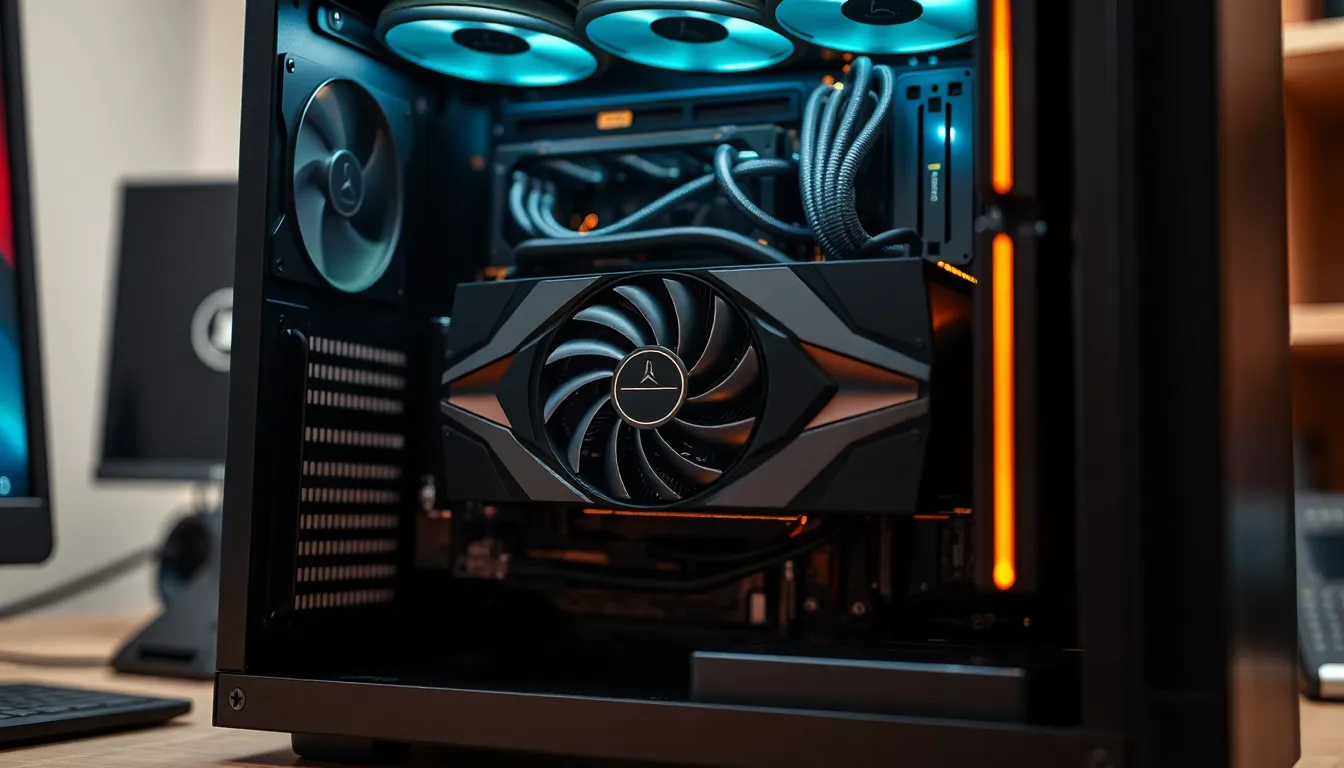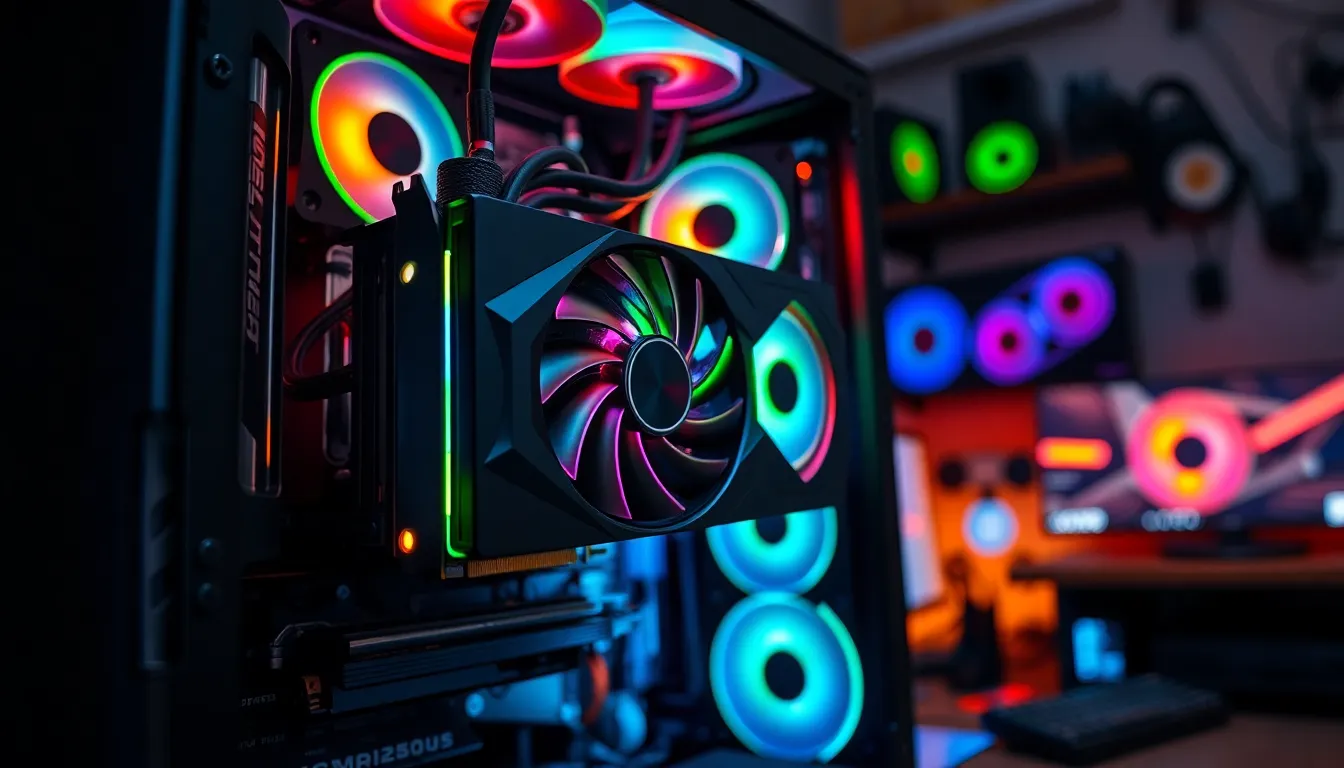In the world of gaming and graphic design, a graphics card is like the engine of a high-performance car. But just like that engine, it can get a little too hot under the hood. Understanding graphics card temperature isn’t just a geeky hobby; it’s essential for keeping those pixel-pushing machines running smoothly. After all, nobody wants their gaming session interrupted by a thermal meltdown.
Table of Contents
ToggleUnderstanding Graphics Card Temperature
Graphics card temperature affects overall performance and system stability. Understanding this concept helps maintain optimal performance during demanding tasks like gaming or graphic design.
What Is Graphics Card Temperature?
Graphics card temperature refers to the heat generated by the GPU during operation. Measurements typically range from 30°C to 85°C, depending on the workload. At idle, most GPUs operate around 30°C to 40°C. When running intensive applications, temperatures can rise significantly. Manufacturers often specify maximum safe temperatures, generally between 85°C and 95°C. Exceeding these limits can result in thermal throttling or even hardware damage.
Importance of Monitoring Temperature
Monitoring graphics card temperature is vital for several reasons. High temperatures can lead to performance drops, known as throttling, affecting gaming fluidity or rendering speed. Frequent overheating may reduce component lifespan, leading to costly repairs or replacements. Regular checks help identify cooling issues, prompting timely interventions, such as cleaning dust or replacing thermal paste. Additionally, maintaining optimal temperatures enhances system reliability, ensuring smooth operation during extended gaming or rendering sessions.
Factors Affecting Graphics Card Temperature

Multiple elements influence graphics card temperature during operation. Understanding these factors helps maintain optimal performance and prevent thermal issues.
Ambient Temperature
Ambient temperature plays a significant role in GPU performance. Operating in a cooler environment typically reduces overall temperatures. Higher room temperatures, conversely, increase GPU heat generation. For instance, a room temperature of 30°C can add several degrees to the GPU temperature under load. Monitoring this environmental factor is crucial for effective cooling.
Airflow and Case Design
Airflow and case design critically affect how well a graphics card dissipates heat. A well-ventilated case allows for efficient airflow, promoting lower temperatures. Restrictive designs can trap hot air around components, leading to increased GPU temperatures. Users benefit from optimizing cable management and installing additional case fans. Effective cooling solutions ensure the GPU remains within safe operating limits.
Overclocking and Load
Overclocking significantly impacts GPU temperature. By increasing clock speeds, users push the GPU beyond its standard performance, generating more heat. Load intensity also affects temperature, with gaming or rendering tasks increasing heat output. For instance, during intense gaming sessions, GPUs can reach temperatures as high as 85°C or more. Striking a balance between performance and temperature is essential for maintaining system stability.
Signs of Overheating
Graphics card overheating can manifest through distinct signs that indicate performance degradation.
Performance Issues
Decreased frame rates during gaming often signal overheating. Players may notice lag or stuttering, which ruins the experience. Reduced performance occurs when the GPU throttles to manage excessive heat. Additionally, prolonged gameplay might cause sudden crashes or freezes due to overheating. These interruptions can be frustrating, especially during critical moments in games. Monitoring temperatures actively helps identify when these performance issues arise. Keeping an eye on GPU statistics allows for timely interventions, ensuring smooth gameplay.
Visual Artifacts
Visual artifacts present another clear symptom of overheating. Users may see glitches like screen tearing, strange colors, or odd shapes while gaming. These irregularities occur when the GPU struggles to process data efficiently. Graphic distortion may indicate that temperatures have exceeded safe limits. Screenshots might reveal these artifacts, showcasing the damage caused by high temperatures. Recognizing these issues promptly can help prevent further overheating. Addressing potential cooling problems ensures stable graphics performance during demanding tasks.
How to Monitor Graphics Card Temperature
Monitoring graphics card temperature is essential for optimal performance. Users can easily track temperatures through various methods, ensuring their systems run smoothly.
Software Tools
Numerous software tools provide real-time temperature readings for graphics cards. Popular options include MSI Afterburner, GPU-Z, and HWMonitor. Each tool offers user-friendly interfaces and precise data, helping users monitor GPU temperatures, usage, and voltage. In addition, these tools often provide customizable alerts for temperature thresholds, ensuring users receive notifications when temperatures approach unsafe levels. Tracking temperature graphs within the software enables users to identify patterns during demanding tasks, enabling better management of cooling solutions.
BIOS Monitoring
Accessing the BIOS can also provide insights into graphics card temperature. On startup, users can enter the BIOS setup, where temperature monitoring practices often display system health data. Typically, this includes real-time readings of the GPU, CPU, and motherboard temperatures. Utilizing BIOS monitoring helps users understand their system’s thermal status without any third-party software. Over time, this method enables tracking of temperature changes during boot-up and idle states, offering valuable insights into components’ performance and potential cooling needs.
Tips for Managing Graphics Card Temperature
Managing graphics card temperature plays a crucial role in maintaining system performance and component longevity. Several effective strategies help keep temperatures under control.
Cleaning and Maintenance
Regular cleaning promotes optimal airflow and cooling. Dust accumulation on GPU fans and heatsinks leads to increased resistance to air circulation, raising temperatures. A compressed air canister efficiently removes dirt and debris. Maintenance routines should occur every few months, especially in dusty environments. Attention to thermal paste is also essential; replacing it every few years ensures efficient heat transfer from the GPU to the heatsink.
Improving Case Airflow
Enhancing airflow inside the computer case significantly impacts graphics card temperature. Positioning fans to create an intake and exhaust system optimizes air movement. Sufficient space around components prevents heat buildup, while cable management reduces clutter that obstructs airflow. Selecting a case with ample ventilation permits cooler air to enter and hot air to exit effectively, which keeps the GPU functioning efficiently.
Using Cooling Solutions
Utilizing advanced cooling solutions contributes to effective temperature management. Aftermarket GPU coolers offer enhanced cooling capabilities compared to stock models. Liquid cooling systems provide superior heat dissipation, reducing the risk of thermal throttling. Thermal pads and fans improve cooling efficiency, allowing the GPU to handle demanding tasks without overheating. Users often find that implementing these solutions maintains stable performance during extended workloads.
Understanding graphics card temperature is essential for anyone engaged in gaming or graphic design. By keeping an eye on temperature levels users can prevent overheating and ensure their systems run smoothly. Regular monitoring and maintenance not only enhance performance but also extend the lifespan of the GPU.
Implementing effective cooling solutions and maintaining proper airflow within the case can make a significant difference. By staying proactive about temperature management users can enjoy uninterrupted gaming experiences and optimal performance during demanding tasks.




